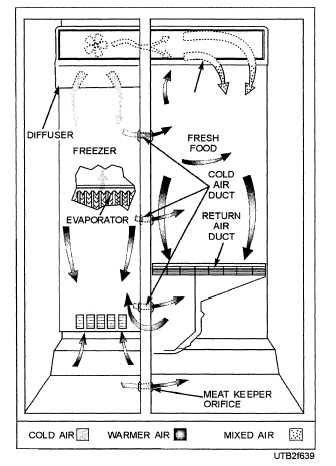condenser is on the back of the cabinet or in the bottom of the cabinet below the hermetic compressor. During operation, the cold air from the evaporator flows by natural circulation through the refrigerated space. The shelves inside the cabinet are constructed so air can circulate freely past the ends and sides, eliminating the need for a fan. This refrigerator has a manual defrost, which requires that the refrigerator be turned off periodically (usually overnight) to enable the buildup of frost on the evaporator to melt. Both the outside and inside finish is usually baked-on enamel. Porcelain enamel is found on steel cabinet liners. The interior of the unit contains the shelves, lights, thermostats, and temperature controls.
Two-Door Refrigerator-Freezer Combination
The two-door refrigerator-freezer combination is the most popular type of refrigerator. It is similar to the fresh food refrigerators in construction and the location of components except it sometimes has an evaporator for both the freezer compartment and the refrigerator compartment. Also, if it is a frost-free unit, the evaporators are on the outside of the cabinet. Because of the two separate compartments (refrigerator-freezer) and the larger capacity, these types of refrigerators use forced air (fans) to circulate the air through the inside of both compartments. The two-door refrigerator also has one of the following three types of evaporator defrost systems: manual defrost, automatic defrost, or frost-free.
There are two types of automatic defrosting: the hot gas system or the electric heater system. The hot gas system, through the use of solenoid valves, uses the heat in the vapor from the compressor discharge line and the condenser to defrost the evaporator. The other system uses electric heaters to melt the ice on the evaporator surface.
A frost-free refrigerator-freezer (fig. 6-39) has the evaporator located outside the refrigerated compartment. On the running part of the cycle, air is drawn over the evaporator and is forced into the freezer and refrigerator compartments by a fan. On the off part of the cycle, the evaporators automatically defrost.
Refrigerator-freezer cabinets are made of pressed steel with a vinyl or plastic lining on the interior wall surfaces and a lacquer exterior finish. Most domestic refrigerators have urethane foam or fiber glass insulation in the cabinet walls. The side-by-side refrigerator-freezer arrangement has a number of features not found in other refrigerators. In addition to

Figure 6-39. - Frost-free refrigerator airflow diagram.
the automatic icemaker in the freezer compartment, it has an option for a cold water dispenser, a cube or crushed ice dispenser, and a liquid dispenser built into the door.
WATER COOLERS AND ICE MACHINES
Water coolers provide water for drinking at a temperature under 50F. Two types of water coolers are instantaneous and storage. The instantaneous type only cools water when it is being drawn; the storage type maintains a reservoir of cooled water. One instantaneous method used places coils in a flooded evaporator through which the water flows. A second instantaneous method uses double coils with water flowing through the inner coil with refrigerant flowing in the space between the inner coil and the outer coil. A third instantaneous method is to coil the tubing in a water storage tank. This allows refrigerant to flow through it (fig. 6-40).
Water coolers are of two basic designs - wall mounted or floor mounted. Both types are the same in construction and operation; the only difference is in the
Continue Reading
